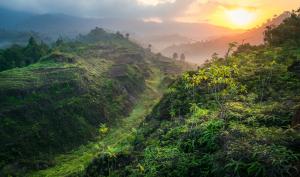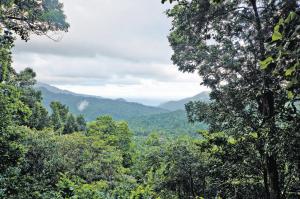New Angle on Theory Explaining Species Diversity in Rainforest Trees
A fall in precipitation due to climate change could alter moisture in the forest floor and harm the interactions between trees, insects and fungi
QIRYAT TIV ON, ISRAEL, September 27, 2023 /EINPresswire.com/ -- A new study led by a researcher of the Oranim College and the University of Haifa, published in the prestigious journal Nature, has found that in conditions of high soil humidity the chances of survival of young tree seedlings growing at high densities are reduced. As a result, in the following year there will be a higher species diversity. “Until now, tests of the theory explaining species diversity of trees in rainforests focused solely on proving the role of each species’ natural enemies, particularly insects and fungi, along rainfall gradients. The current study is the first to focus on how the conditions that allow these enemies to flourish change through time and indirectly affect tree diversity” explains Dr. Edwin Lebrija-Trejos, one of the authors of the study.
The rainforests are a complex ecosystem that is vital for the maintenance of the planet, for which they serve as “green lungs.” A key feature of the rainforests is the high level of species diversity in trees, a characteristic that is vital for the proper functioning of the ecosystem. Species diversity allows the forests to be resilient by covering the ecological functions performed by an individual species with similar ‘spare’ species in case of key species losses.
The current study by Dr. Lebrija-Trejos from the Department of Biology and Environmental Sciences at the University of Haifa (Oranim Campus), together with researchers from the Smithsonian Tropical Research Institute in Panama, is based on a theory formulated 50 years ago by Janzen and Connell that is one of the prominent approaches to species diversity in forests. “One factor that helps maintain a high level of plant diversity in rainforests are the natural enemies of the various species. The basic idea behind this theory is that the natural enemies of plants – insects or fungi – are unique to each species, or at least mainly harm one specific species. If one species becomes more dominant and dense, its natural enemies will thrive and harm it, particularly in the case of young seedlings. This will in turn allow other species to establish and increase their population size. This process creates a natural cycle that prevents one particular species of trees from maintaining a dominant position on a long-term basis, and this process helps maintain species diversity in the forest,” comments Dr. Lebrija-Trejos.
The model Dr. Lebrija-Trejos developed is based on the hypothesis that if the natural enemies theory is correct, the conditions that allow their development should be an important factor in the effectiveness of the mechanism. Since these suspected enemies are moisture responsive insects and fungi, in a rainy season when the soil becomes saturated such enemies will thrive, and thereby help to strengthen the mechanism and make it “work better.” In a dry year, the soil will remain dry and the result will be the opposite.
In order to prove this assumption, however, the researchers needed a large quantity of data. Fortunately, plentiful data are available for the rainforests of central Panama. Since the 1990s, Dr. Joe Wright, a partner in the study, has managed 800 plots, each one square meter in size, recording information each year about which saplings survived and which died. The researchers also used a database including a count and description of every tree with a trunk wider than one centimeter at a height of 1.3 meters. The database relates to a 50-hectare research plot and has been maintained since the 1980s. By cross-referencing these two databases, the researchers could find out for each year which sapling survived, which died, and what other trees were in the immediate surroundings – in other words, whether that species was dominant in the area or not. A third database used by the researchers included soil humidity and precipitation figures for the past century. This information helped the researchers to identify the driest and wettest years over the century. These end values were measured from the 1990s on.
The findings show that in years with high soil humidity, species that have a dense presence have a lower chance of survival, so that in the following year there will be a greater tree diversity. Accordingly, the diversity of trees is higher after a year when soil humidity was high than after a year with low soil humidity. In other words, the results suggest that in wet years the insects and fungi thrive and can “do their job” of thinning out dominant tree species. The researchers also sought to prove that the significant factor is the flourishing of insects and fungi, rather than the fact that wet years are “good” for all species of trees and that this is the reason for the heightened diversity. To this end, they examined survival where a particular species were not present in high density and showed that in these conditions a wet or a dry year did not have a significant impact on tree survival. In other words, it is only the combination of density and dominance of one species together with a wet year and high soil humidity that likely led to an increase in the trees’ natural enemies, and in turn to higher species diversity in the following year.
“Our model proves that aridity and humidity have an indirect impact on species diversity. The more dry years or conditions we experience, the greater the threat of damage – not only to species diversity in rainforests, but also to the contribution these forests make to humanity,” concludes Dr. Lebrija-Trejos.
tali laufer
Oranim College
email us here
Visit us on social media:
Facebook
Instagram
YouTube
Legal Disclaimer:
EIN Presswire provides this news content "as is" without warranty of any kind. We do not accept any responsibility or liability for the accuracy, content, images, videos, licenses, completeness, legality, or reliability of the information contained in this article. If you have any complaints or copyright issues related to this article, kindly contact the author above.


